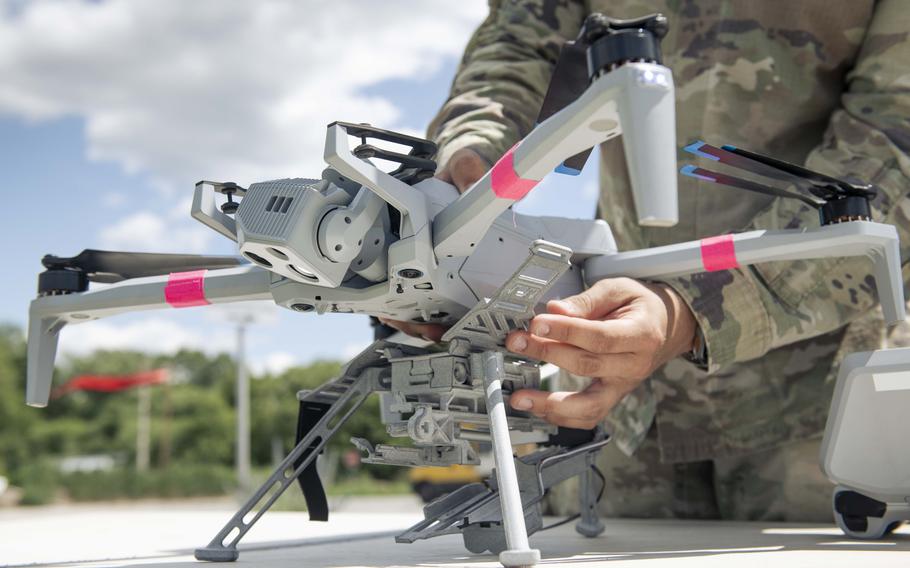
Spc. Michael Fish, an unmanned aerial systems operator with 1st Squadron, 91st Cavalry Regiment, attaches a 3D-printed munitions dropper to a Skydio X10D drone at Grafenwoehr Training Area in Germany on June 25, 2025, during a test in which soldiers dropped live M67 grenades from the drone. (Lydia Gordon/Stars and Stripes)
GRAFENWOEHR, Germany — The U.S. Army took a step toward integrating killer drones into its battlefield tactics after it dropped live grenades from the air at a training area in Germany this week.
Members of the 278th Armored Cavalry Regiment of the Tennessee Army National Guard on Wednesday became the first conventional soldiers to detonate an M67 fragmentation grenade from a drone-borne dropper, Army officials on site said.
The plastic device, known as Audible, was attached to the undercarriage of a Skydio X10D drone that attacked a simulated vehicle convoy at the Grafenwoehr Training Area.
On Wednesday, 1st Lt. David Baker checked Audible’s dropper device. He then attached a hand grenade, making sure the pin was in the correct position to be pulled. He removed the safety clip and the drone was airborne.
Maj. Phillip Draper watched from a television screen in a nearby control tower as the drone flew toward three simulated stationary vehicles. The falling grenade struck right next to the lead vehicle’s passenger side.
“It was a successful test,” Draper said. “Hopefully we can build on this and make it better and then get those results to the warfighter.”
After that test, though, the Audible cracked in a hard landing and a 3D-printed version made by soldiers from the 173rd Airborne Brigade filled in with inert rounds for additional drone test flights.
The successes and failures each provide valuable data. Within a couple of hours of the test and crash-landing, the Combat Capabilities Development Command at Aberdeen Proving Ground, Md., had been notified and seven more devices were on the way.
“We’re dropping a regular ordnance that every soldier would carry in combat,” said civilian David Oeschger, deputy of operations for the 7th Army Training Command, which hosted the test. “We’ve learned well from the Ukrainians and the Russians on how we are going to use this system in the next fight.”
Dropping grenades with drone-mounted devices like Audible will become a part of normal Army training within months, Oeschger said.
The U.S. Army, which trains Ukrainian soldiers at locations including Grafenwoehr, updated its fighting doctrine last year due to lessons learned in Ukraine. The service now seeks to constantly evolve and leverage mobility, speed, deception and technology.
The ability of small, off-the-shelf drones to carry munitions to strike personnel, armor and command posts has dramatically changed military strategy and tactics.
More tests are planned for the Audible, which was developed by the Maryland-based command.
This “really expands the arsenal, being able to go out and reach targets beyond the front line of troops and putting that at the lowest level,” Baker said.